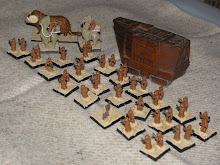During the late 1990s, a few of the people I was playing CD with decided to have a crack at playing Napoleonics. HaT had started making its range of Napoleonic figures, Airfix figures were available as both reissues from HaT and Airfix, Revell sets were easily available, and Italeri were releasing figures that went well with the old Esci sets. It was a good time to start amassing 20mm plastic Napoleonic figures.
 |
| My French take the field once more. |
However, we couldn't find asset of rules that we agreed on, or were easily available. Fortunately, we did have copies of the playtest version of 'Black Powder, Cold Steel' (BPCS), that was included in the boxed set of CD2. Since we all knew how to play CD, and this set of rules was merely adding a few tweaks to the basic game in order to handle gaming in pre 20th century conflicts, it was the one we ended up using.
 |
| Steve's Prussian menace to the French way of life. |
The base gaming element in BPCS was the company stand, having four figures mounted on it in two ranks, and representing 50-200 men. This functioned in BPCS much in the same way as a platoon stand does in CD. The game itself played much like CD, with the major difficulty being that the scale of the forces used made it cumbersome to play larger battles, and the CD/BPCS ground scale made battalion squares too large, while the additions to the movement system made forming them extremely annoying.
My understanding is that BPCS was abandoned by GDW, with Mr Chadwick heading down the path that eventually created 'Volley and Bayonet'. The idea of using the CD rules engine as a universal wargames system has stuck with me, and recently I figured out a possible way of achieving this, whilst solving some my issues with V&B.
The solution was to use the basing system from V&B, its strength point system, and couple that to the mechanisms of BPCS. All that remained was for this to be put to the test in a game. Steve was persuaded to take part, and proceeded to rebase his very nice Revel and HaT Prussians from BPCS to V&B. A big factor in him doing this, is the aesthetic appeal of the 3"x3" stands.
So a couple of weeks back, Steve and I had a crack at putting this into practice. Steve fielded a 1813/14 Prussian force, while I fielded a French force of a similar vintage. Each turn would represent an hour - the same time scale given in V&B, and the recommended time scale in CD for games involving primarily infantry forces.
 |
| The battlefield. Steve's terrain is generally from GW or is a Gale Force 9 product. All very nice stuff indeed. |
Steve's forces were organised along the following lines:
The Prussians: Morale 10
Corps Headquarters w/
1 Command Stand []
1st Division w/
Command Stand []
Infantry Stand [][][][]
Infantry Stand [][][]
Infantry Stand [][][][]
2nd Division w/
Command Stand []
Infantry Stand [][][][]
Infantry Stand [][][][][]
Infantry Stand [][][][]
Cavalry Division w/
Cavalry Stand [][][]
Cavalry Stand [][][]
Corps Artillery w/
Artillery Stand [][][]
Artillery Stand [][][]
Artillery Stand [][][]
Artillery Stand [][][]
Each [] is a strength point representing around 500 men. This breaks down horribly in the case of the command stands, but consider it a working cludge until a suitable rules melding/fudging happens. Post game we worked out that Steve was fielding around 15300 men.
Also note that I haven't factored troop quality into the equation yet, nor fully resolved the RoF problem from BPCS regards CD3, or V&B. More cludges are required, but the main point was to test how the command and control mechanisms that are the heart of CD could be used in playing a game of Napoleonics.
 |
| Prussian gun carriages are blue. Figures are HaT Prussian Artillery. |
My force was organised along the following lines:
The French: Morale 9
Corps Headquarters w/
1 Command Stand []
1st Division w/
Command Stand []
Infantry Stand [][][]
Infantry Stand [][][][]
Heavy Cavalry Stand [][][]
2nd Division w/
Command Stand []
Infantry Stand [][][][][]
Infantry Stand [][][][]
Infantry Stand [][][][]
3rd Division w/
Command Stand []
Infantry Stand [][][][]
Infantry Stand [][][][]
Infantry Stand [][][][]
Light Cavalry [][][]
Corps Artillery w/
Artillery Stand [][][]
Artillery Stand [][][]
Artillery Stand [][][]
We
fudged another number worked out later that my French Corps was around 19300 men strong.
 |
| Now all I had to do was deploy outside the woods, cross the road, and drive Steve back across the river. |
As I had the larger force, I would be the attacker. This was going to be interesting....






















































